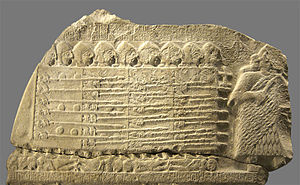The phalanx (Ancient Greek: f??a??, Modern Greek: f??a??a, phalanga; plural phalanxes or phalanges; Ancient and Modern Greek: f??a??e?, phalanges) is a rectangular mass military formation, usually composed entirely of heavy infantry armed with spears, pikes, sarissas, or similar weapons. The term is particularly (and originally) used to describe the use of this formation in Ancient Greek warfare, although the ancient Greek writers used it to also describe any massed infantry formation, regardless of its equipment, as does Arrian in his Array against the Alans when he refers to his legions. In Greek texts, the phalanx may be deployed for battle, on the march, even camped, thus describing the mass of infantry or cavalry that would deploy in line during battle. They marched forward as one entity, crushing opponents. The word phalanx is derived from the Greek word phalanx, meaning finger.The term itself, as used today, does not refer to a distinctive military unit or division (e.g., the Roman legion or the contemporary Western-type battalion) but to the general formation of an army's troops. Thus a phalanx does not have a standard combat strength or composition but includes the total number of infantry, which is or will be deployed in action in a single phalanx formation.Many spear-armed troops historically fought in what might be termed phalanx-like formations. The word has come into use in common English to describe "a group of people standing, or moving forward closely together"; c.f. "a phalanx of police".This article focuses on the use of the military phalanx formation in Ancient Greece, the Hellenistic world, and other ancient states heavily influenced by Greek civilization.The earliest known depiction of a phalanx-like formation occurs in a Sumerian stele from the 25th century BC. Here the troops seem to have been equipped with spears, helmets, and large shields covering the whole body. Ancient Egyptian infantry were known to have employed similar formations. The first usage of the term phalanx comes from Homer's "(fa?a??)", used to describe hoplites fighting in an organized battle line. Homer used the term to differentiate the formation-based combat from the individual duels so often found in his poems.Historians have not arrived at a consensus about the relationship between the Greek formation and these predecessors of the hoplites. The principles of shield wall and spear hedge were almost universally known among the armies of major civilizations throughout history, and so the similarities may be related to convergent evolution instead of diffusion.Traditionally historians date the origin of the hoplite phalanx of ancient Greece to the 8th century BC in Sparta, but this is under revision. It is perhaps more likely that the formation was devised in the 7th century BC after the introduction of the aspis (a shield also known as the hoplon) by the city of Argos, which would have made the formation possible. This is further evidenced by the Chigi vase, dated to 650 BC, identifying hoplites armed with aspis, spear and panoply.Another possible theory as to the birth of Greek phalanx warfare stems from the idea that some of the basic aspects of the phalanx were present in earlier times yet were not fully developed due to the lack of appropriate technology. Two of the basic strategies seen in earlier warfare include the principle of cohesion and the use of large groups of soldiers. This would suggest that the Greek phalanx was rather the culmination and perfection of a slowly developed idea which originated many years earlier. As weaponry and armour advanced through the years in different city-states the phalanx became complex and effective.




Aipatu
0